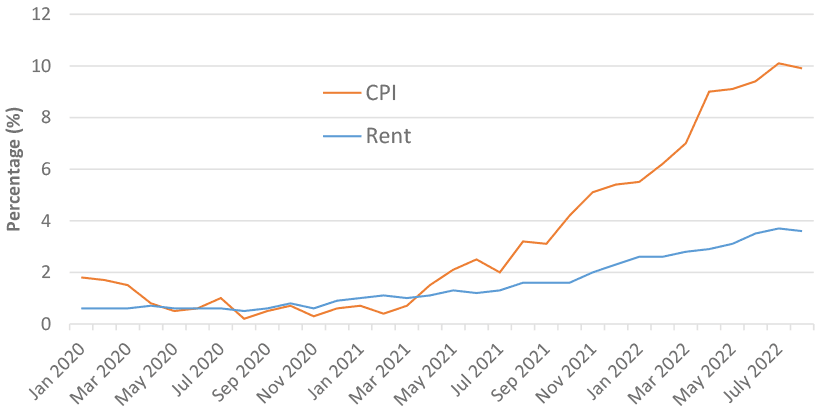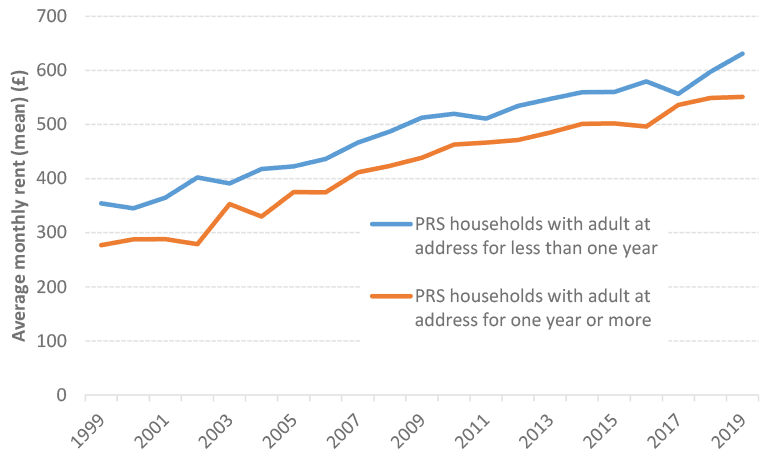Cost of Living Bill: economic background
Summarises recent economic trends which informed the development of the Cost of Living (Tenant Protection) Scotland Bill, which was introduced to the Scottish Parliament on 3 October 2022.
5. Trends in rents
Figures from the ONS Private Rental Index show that the annual increase in private rents across all tenants in Scotland has been accelerating over recent months. The increase of 3.7% in July 2022 was the highest since the series started in 2012, and the index remained at an elevated level of 3.6% in August 2022.

Sources: ONS Index of Private Housing Rental Prices and Consumer price inflation.
Note that the ONS figures are experimental statistics incorporating an assumption relating to average tenancy length to account for rents to sitting tenants, and therefore will differ from separate recent lettings-agency figures that cover advertised rents only. The ONS series also only reports on national level increases, and beneath this increases in rents in some areas of the country are likely to vary.
Therefore, looking at latest data from letting agents (noting that they will not have compete market coverage) for the latest quarter Apr-Jun 2022 compared with Apr-Jun 2021, Citylets have reported that advertised rents have increased by 15.1% in Edinburgh, 13.0% in Glasgow, and 4.4% in Aberdeen.[6] Rightmove have reported that advertised rents in Scotland have increased by 12.5% over the same time period.[7]
With respect to the issue of how often rents are increased, a variety of anecdotal and survey evidence suggests that a significant share of sitting tenants do not experience a rent increase each year. A survey of tenants undertaken for the Nationwide RentBetter Project found that over half of tenants responding to the survey had not experienced a rent increase during their current tenancy.[8] This is due to a combination of high levels of turnover in the private rented sector (Scottish Household Survey data shows that around a third of tenants have been in their property for less than a year)[9] and landlord rent setting approaches. A survey of landlords and letting agents undertaken for the RentBetter project reported that of those responding to the survey, around half reported never increasing rents or only on change of tenancy.[10] Of the remainder, only around a third reported that they increased rents each year, and for landlords who increase rents less frequently than each year, only a portion of their tenants will experience a rent increase in any given year.
Taken together, the evidence suggests that of those tenants who have been in their property for at least a year, significantly less than half would expect to have a rent increase during the course of a year. Assuming that the starting dates of tenancies are approximately equally distributed over the course of a year, this would suggest that significantly less than a quarter of sitting tenants who have been in their property for at least a year would experience a rent increase over a 6-month period.
Data from the Scottish Household Survey (Figure 8) which shows that average rents to tenants who have been in their property for more than a year are consistently below average rents for those who have been in their property for less than a year is consistent with this analysis.

Source: Scottish Government analysis of Scottish Household Survey data
It should be noted that the RentBetter research also found that landlords were much more likely to raise rents regularly in Edinburgh, where rents have been rising faster than in Scotland as whole.[11] This suggests that while, when market rents are not growing too fast, landlords may prefer to wait to the end of what are often relatively short tenancies before they reset rents, since the gap between the rent paid by their sitting tenant and the market rent will not be too large, and they may be reluctant to disturb their relationship with their tenant,[12] landlords do adapt their behaviour when market rents are rising more significantly. This would suggest that the share of tenants who would experience a rent rise over the next six months in the absence of legislation may be higher than would usually be the case, given the acceleration in average Scottish rents reported by the ONS Private Rental Index.
Contact
Email: Bruce.Teubes@gov.scot
There is a problem
Thanks for your feedback